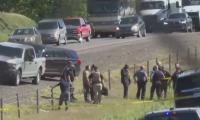Before the attack in Christchurch, very few people expected New Zealand would witness a terror incident of such magnitude. To all outward appearances, we were a very safe and tolerant society. The Global Peace Index had New Zealand as the second most peaceful country on the planet. Our terror rating was “low” (meaning attacks were believed to be unlikely) and we had a national homicide rate by firearms (about 10 a year for the whole country) that was insignificant by international standards.
Despite these considerations, at the end of August 2016, I warned a select committee of the New Zealand government which was looking into gun regulation legislation that the risk of a mass shooting in the country was rising due to the growing threat from extremists and the possibility of “lone wolf” attacks following recent incidents in Europe and the United States. To me, it was foreseeable that there would be an atrocity in my country. Yet my predictions were laughed off and I was perceived as being melodramatic.
The reason why I believed a major attack was inevitable was that I could see two major factors related to mass shootings and terrorism taking shape in the New Zealand context.
Attackers often profess extremist views or follow an ideology which justifies violence against innocent people. In New Zealand, I could see the extreme right, while small in numbers (perhaps a couple of hundred), becoming increasingly active. It was learning from other extremist groups abroad and was being nurtured by virulent like-minded haters over the internet. At the same time, the authorities did not take any serious action to address the security threat far-right activism posed, nor to counter its poisonous rhetoric. Too many people looked the other way, believing that the extreme right in New Zealand was harmless.
Although some in the New Zealand intelligence community heard what I and others were warning about, the issue was not given a high priority. The security agencies were much more preoccupied with investigating potential “jihadis”, criminal gangs, or Maori “separatists”.
The result was that the extreme right was largely overlooked, as the intelligence community spent millions chasing other would-be terrorists, some real, some imaginary. In practical terms, this meant that there was probably a considerable degree more surveillance of mosques and Muslim worshippers than far-right extremists like Brenton Tarrant and the shooting clubs and chat rooms they were frequenting.
Attackers also need easy access to weapons in order to commit a terror act. New Zealand’s rate of gun ownership is one of the highest in the world and civilians are able to legally obtain semiautomatic guns. Had the perpetrator of this terror attack attempted to do it with a firearm which could only fire one or two bullets before being reloaded, he would have been quickly overpowered and the death toll would have been much lower.
The Australians, like the British before them, figured this one out after suffering a number of large-scale mass shootings. As a result, both countries prohibited semiautomatic firearms which multiplied death tolls from single figures to the dozens. They also implemented elaborate amnesty and buy-back programmes to take as many guns out of circulation as possible.
The New Zealanders did not learn from the Australian or British experience. Despite firearms only being a legal privilege, and not a legal right (like in the US), successive New Zealand governments preferred to close their eyes and cross their fingers that the overseas problems would not hit their country.
This article has been excerpted from: ‘New Zealand was warned a terror attack was possible’. Courtesy: Aljazeera.com
A health worker administers polio vaccine drops to a child during a door-to-door polio vaccination campaign in Lahore,...
Armed militants of the banned Tehreek-e-Taliban Pakistan pose for a photograph in Orakzai Agency. —...
An aeroplane of the national flag carrier of Pakistan is seen in this file photo. — AFPWhile Pakistan considers...
Representational image of a graph depicting various variables. — APP/FileInitiated by the centre and fiercely...
In this picture taken on April 16, 2023, people throng a market area during shopping in Lahore. — AFPOne of the...
Honour crimes also target men. In Sikandar Ali Lashari vs The State, SHC upheld conviction passed by ATC for honour...







